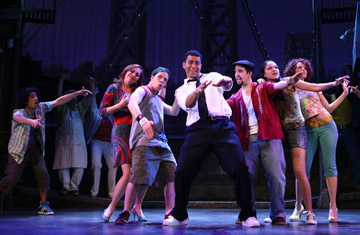
In the Heights uses hip-hop and salsa to animate its family-friendly tale about the residents of a Latino neighborhood on the verge of change
Compared with the crowded, colorful displays of loot in most Broadway theater lobbies, the merchandise counter for Rent looks downright spare: a modest assortment of sweatshirts, mugs, CDs and T shirts in basic-grunge black-and-white. The show, too--on my first return visit since reviewing it 12 years ago--looks a bit paler than it did back in 1996, when it opened off-Broadway to so much acclaim that it made the jump to Broadway just two months later. The aids-centric story lines in this East Village update of La Bohème seem a little dated now, and the umpteenth replacement cast doesn't have the snap, or the voices, of originals like Anthony Rapp and Idina Menzel. Still, when the last performance of Rent plays on June 1, ending the seventh longest run in Broadway history, it will leave a void on the Great White Way, and theater watchers are already asking the question, Where will Broadway find its next Rent?
Which is to say, the next hit musical that will attract a younger, more diverse audience than the relatively homogeneous (older, upscale, largely white) folks who usually fill the orchestra seats. It's a crowd that Broadway has been chasing for years. Hair was the first show to really tap into the sensibility and musical tastes of a young generation, and plenty of musicals since then have tried to bring rock (or at least rocklike) music to the land of Stephen Sondheim and Jerry Herman. None, however, were as successful as Rent, which has grossed more than $280 million on Broadway, helped by a fervent audience of kids, many of whom saw the show multiple times.
But Rent didn't exactly start a revolution. Broadway continues to do robust business; total attendance climbed 2.7% last year, to a record high of 12.3 million. But the vast majority of hit musicals since Rent, from The Producers to Jersey Boys, still earn their money the old-fashioned way: by catering to comfortably middlebrow, middle-aged audiences.
That, however, may be starting to change. The big news last season was the unexpected success of Spring Awakening, a hard-edged, hard-rocking musical about the sexual coming-of-age of teenagers in repressed 1890s Germany. It's the sort of show that a few years ago would have been satisfied with a critically acclaimed run at a hip downtown theater--where, in fact, Spring Awakening began life in 2006. But the show, buoyed by good reviews, transferred to Broadway the following spring and awakened to find itself, against all odds, a multiple Tony winner and a box-office hit.
Now Broadway is about to welcome two more unconventional shows from off-Broadway that are hoping to reel in the sort of people who have traditionally turned their noses up, and their iPods off, at show-tunes-style musicals. One of them, Passing Strange, is an idiosyncratic mix of rock concert and theatrical bildungsroman, presided over by a Los Angeles-based alt-rocker named Stew. The other, In the Heights, is a Latin- and hip-hop-flavored love letter to the Hispanic neighborhood of Washington Heights in upper Manhattan. The two shows have little in common except that neither could by any stretch of the imagination be mistaken for Phantom of the Opera.
They don't look a lot like Rent either. That show, for all its breakthroughs, had an audience dominated largely by white kids from the suburbs. Meanwhile, Broadway audiences have been growing steadily more diverse in recent years; according to Theater League figures, about 26% of all Broadway theatergoers last season were non-Caucasian, a record high. One big reason was The Color Purple, the hit musical based on Alice Walker's novel of the same name, backed by the seemingly unstoppable Oprah Winfrey.
But The Color Purple is really an old-fashioned musical dressed up in new colors. Most of the shows that are expanding the musical's horizons are more personal and experimental--the work of artists who are approaching Broadway with a refreshing lack of preconceptions. And audiences, despite all the Internet-age doomsayers, may be ready for them, judging from the excitement generated by shows like Spring Awakening. "Theater is becoming groovy and cool again," says Kevin McCollum, a co-producer (along with Jeffrey Seller and Jill Furman) of In the Heights as well as Rent. "As technology is isolating us more and more, I think there is a thirst to gather. Actually having to show up somewhere at 8 o'clock, being part of a community, is very healing and powerful." What's more, the eclipse of the concept album, which has accompanied the rise of iTunes and the return to primacy of the single, may be making the Broadway stage more attractive to composers who want to tell stories, not just write songs.
